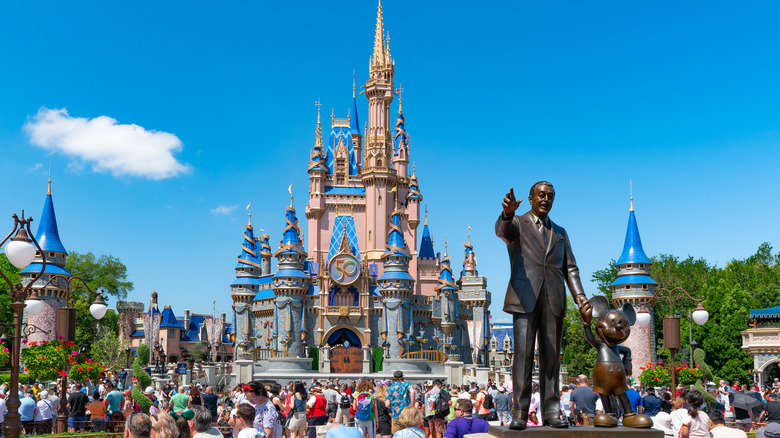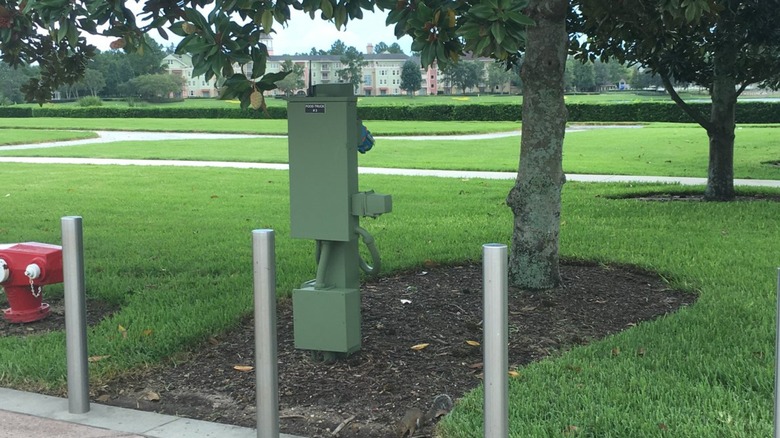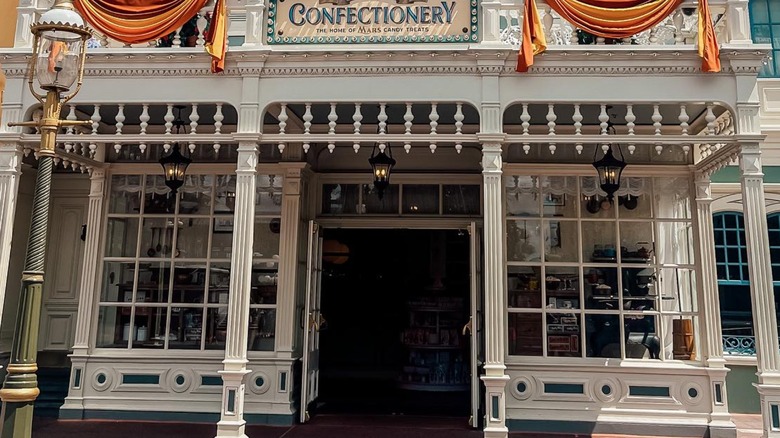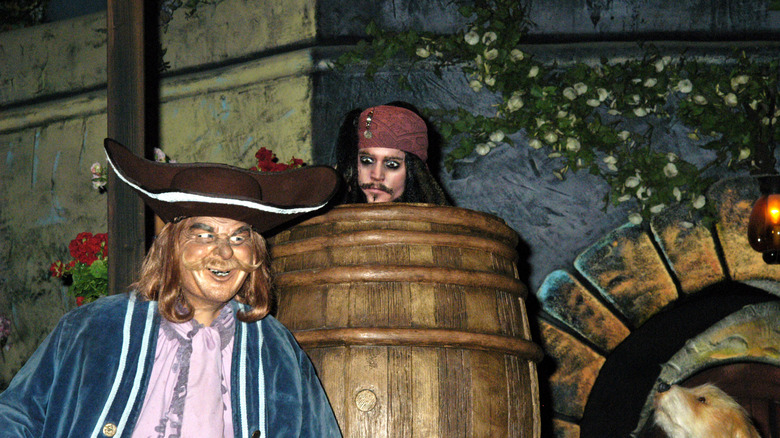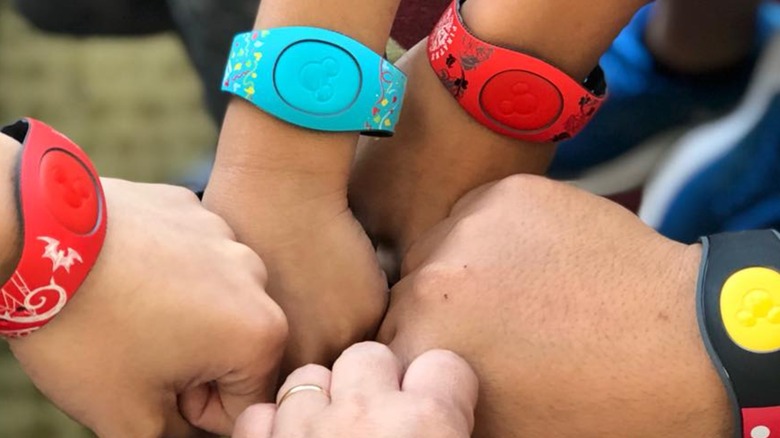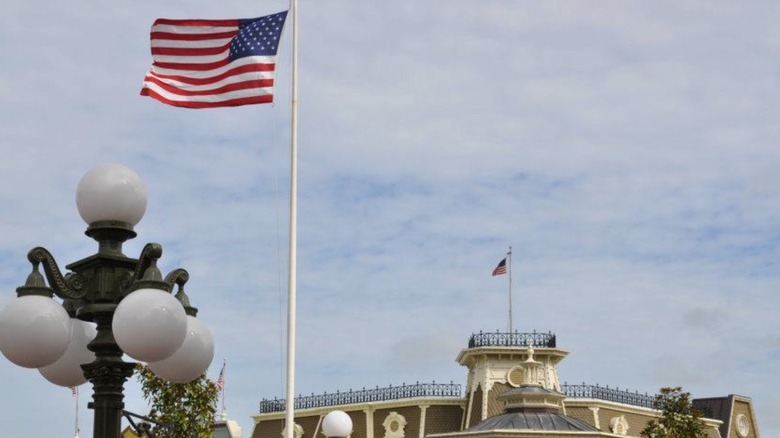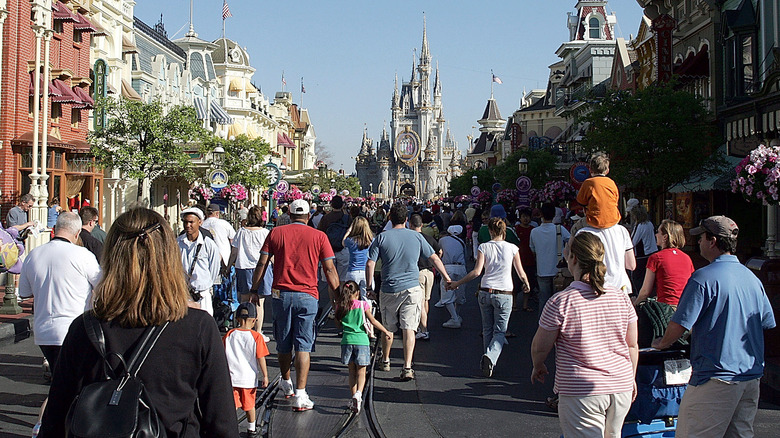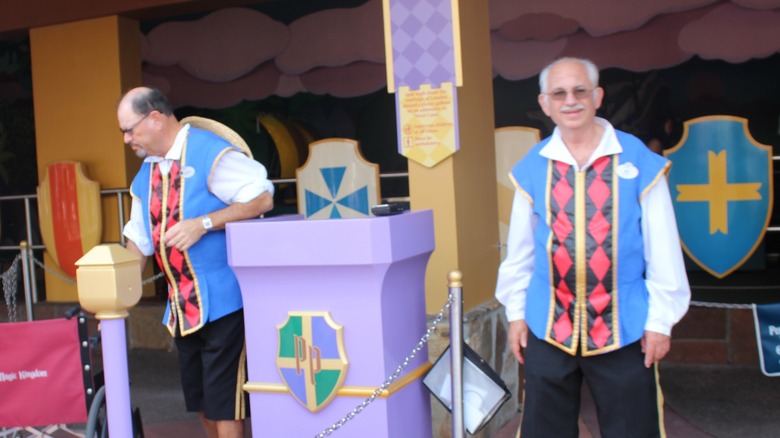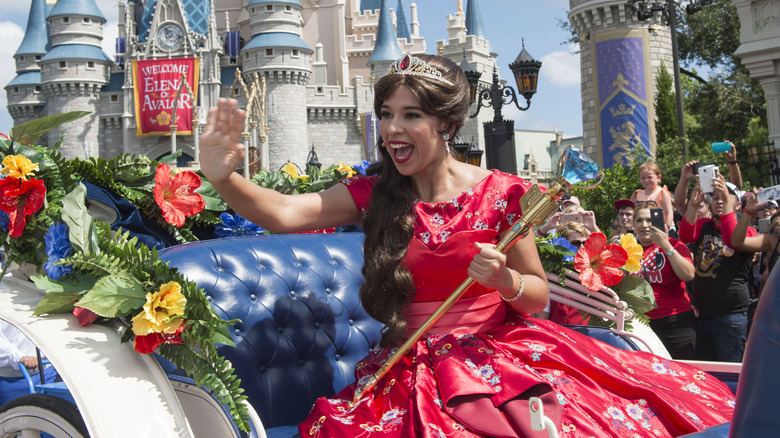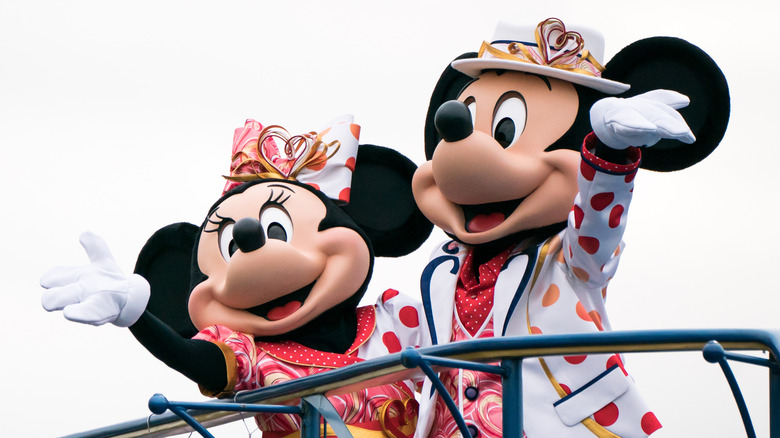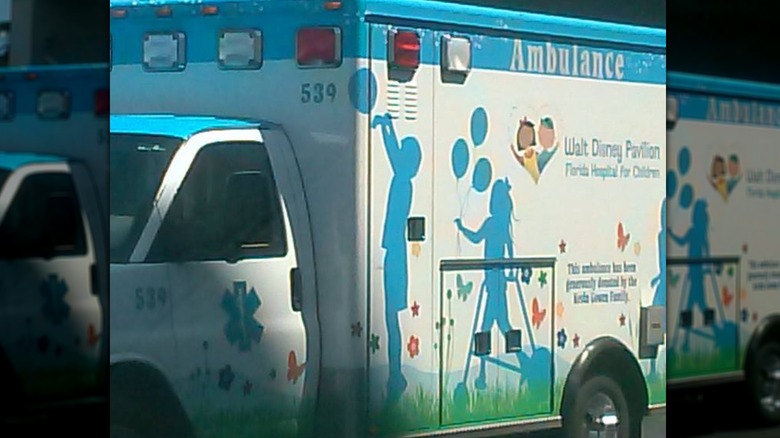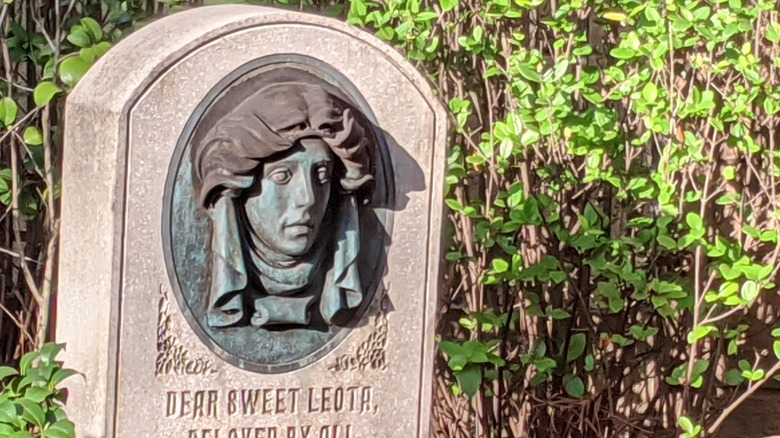The Shady Side Of Disney Parks
There are plenty of reasons no other theme park franchise holds a candle to the Disney Parks experience. From the parks themselves to the merchandise, food, and resort hotels, every detail is meticulously branded and perfectly curated. The end result is an immersive experience that transports guests to a world where dreams are possible and joy is everywhere.
But nobody can be perfect all the time, not even Disney. Creating that perpetually optimistic atmosphere of Disneyfied perfection often requires pulling off clever illusions or even outright trickery. From fairly innocuous sleight of hand to outright deception, even Disney has its shadier side.
At the end of the day, digging up Disney dirt doesn't make the Dole Whip any less delicious. It's just a reminder that at the end of the day, they're just another corporation with a bottom line — they just hide it better than most. Hang onto your mouse ears as we take a look at the shady side of Disney Parks.
They use a special paint color to make ugly things magically vanish
If you ever get the feeling that Disney is just a little too perfect, know that it's all part of the park's clever sleight of hand. Disney Imagineers know better than most that magic isn't just about kicking up the wow factor. Often, the things you don't see are just as important when it comes to pulling off the perfect vacay — like the fact that Disney Parks stay almost completely free of trash. And then there's the way Disney Imagineers manage to draw guests' eyes away from all of the physical infrastructure that might otherwise take them out of the fantasy.
Using a special paint known as Go Away Green, aka Disney's version of camouflage, two proprietary colors are so effective at hiding things in plain sight that guests see them all day long and typically don't register them. Our eyes naturally tend to overlook mundane pastels that blend into the landscape, focusing instead on the more eye-popping colors of attractions like Main Street and Cinderella Castle.
The grayish Go Away Green helps speakers, construction walls, and partitions blend into the background. The color is even used to detract from the door of DIsney's exclusive private membership joint, Club 33. Its dull bluish counterpart, Blending Blue, is typically used to hide or blend buildings into their surroundings. Several examples of both can be seen in a TikTok video from The Mouselets that went viral in 2022.
Those magical scents are a lie
If alternate realities exist, somewhere there's a world where every movie theater features built-in Smell-O-Vision thanks to the 1940s efforts of Walt Disney. According to D23, the official Disney Fan Club, Disney first began exploring the idea of scented cinemas for "Fantasia," which he hoped to make a fully immersive experience all the way down to the moviegoers' olfactory senses by engineering theatre-filling fragrances like gunpowder for spellcasting and perfume during the wildflower dance.
While his scented movies weren't meant to be, Disney put his smell tech to good use at Disney Parks by pumping fragrances into the air to maximize the magic. According to Disney Parks Division veteran Jody Jean Dreyer, who wrote "Beyond the Castle: A Guide to Discovering Your Happily Ever After," Disney taps into the psychology of scent to help amplify guests' experience. To deliver smells throughout the park, Imagineers use a patented technology called the Smell-Emitting System — known colloquially as the Smellitizers.
Smellitizers can be found throughout the parks and even on rides. They deliver the scent of popcorn and candy to guests strolling down Main Street. On the EPCOT ride Soarin', the smell of pine trees, orange groves, and ocean water all wash over Disney guests. Smellitizers even transport park attendees to Captain Jack's waters on the Pirates of the Caribbean ride with scents like leather and gunpowder.
Pirates of the Caribbean once featured real bones
Perhaps no corporation has generated more modern folklore and urban legends than the world of Disney Parks. But occasionally, they turn out to be true, like the claim that Disney Parks has a fancy secret club hidden in plain sight. Then there's the once true but now outdated claim that yelling "Andy's coming" would cause all of the Disney "Toy Story" characters to suddenly drop.
As it turns out, the decades-old rumor that Disney's iconic dark ride, Pirates of the Caribbean, once contained real human bones is also true. Like any good pirate story, the classic boat ride, which originally opened in 1967 at Disneyland, features no shortage of three things: Boozing buccaneers, pillaged treasure, and bones. In his book "Pirates of the Caribbean: From the Magic Kingdom to the Movies," veteran Imagineer Jason Surrell claims that rumors about those bones' authenticity are rooted in truth.
According to Surrell, after designing the ride's background and populating it with animatronic swashbucklers, Imagineers felt they'd done a pretty convincing job. But there was just one problem: The fake skeletons available in the 1960s were just a little too kitschy to be taken seriously. Fortunately, somebody had a pal in the anatomy department at UCLA who was willing to give them the hookup. If that sounds ethically dodgy, Surrell insists the park has since replaced the real bones with suitable replacements.
They're tracking guests' every move
In the hyper-connected world of Google timelines and data mining, most folks have accepted the unpleasant but unavoidable fact of modern life that we're Big Brothering ourselves. And no place is free from technology's watchful eye — not even your dream Disney vacation.
Just like Santa Claus, Disney sees you when you're sleeping and knows when you're awake thanks to their colorful MagicBands — handy plastic RFID bracelets that were first rolled out in 2013. Using biometrics and other personal data, these bracelets serve as guests' entry tickets into the park, FastPass trackers, and more. Guests can even scan them to make purchases and send merchandise back to their hotel rooms. And you know those photos that ride operators take of guests mid-ride? Thanks to your MagicBand quite literally monitoring your (almost) every move and recording every ride or shop you visit, you can log in when you get home and check the photos out.
Gizmodo's Adam Clark Estes recounted the surreal experience of getting evacuated from Splash Mountain and then, moments later, receiving a photo of his empty raft via phone text. According to a Disney spokesperson, this happened because the rides read guests' MagicBands after boarding before connecting their photos to their Disney Park accounts.
There's something off about their U.S. flags
There's nothing like taking a leisurely stroll down Main Street U.S.A., an uncannily wholesome, fictional American town from a time long past. Guests love snapping pics of its perfect little shops and high-flying flags. But as they share their vacation photos with friends back home, a few more scrutinizing folks have started to notice something strange lurking in the background: Flags with fuzzy math. The Internet buzzed with the discovery as folks began to notice flags with the wrong number of stars. Soon, rumors began to crop up around the Internet that Disney uses poser flags so they don't have to respect flag code by taking every single flag down or lowering them to half-mast.
But that doesn't necessarily mean someone at Disney's props department sat around and decided to come up with a bunch of fake flag concepts to scatter across the parks. As some seriously eagle-eyed experts have noted, the flags that don't have 50 stars — one for each state as of 2023 — seem to represent U.S. flags of the past. Since areas like Frontierland and Main Street are meant to be something of a time warp, including a flag with 45 or 48 stars makes a lot more sense. According to the Disney Parks Blog, eager flag spotters can also find examples of the historic John Cabot flag, Pine Tree flag, Grand Union flag, and many more waving around the park.
The Magic Key Pass turned out to be less than magical
Even Disney has its bad days. And for a brand built on family-friendly magic, it doesn't get much worse than losing a lawsuit over deceptive practices as the company did in 2023 when its Magic Key Pass — Disneyland's annual pass program — turned out to be a little less magical for some Disney guests than others. The fallout proved so serious that Disney even paused new Magic Key pass sales while the company regrouped.
When you purchase a Disney park ticket, you're buying it to use on a certain date. Magic Key holders are able to reserve their tickets in advance, ostensibly with more dates open to higher-tiered key holders. The program rolled out during the waning days of the pandemic, and many cooped-up Disney adults loved the promise that they would be able to book reservations "most days of the year" with an Inspire-level Key. So when many found their efforts to reserve a spot thwarted by blocked-out dates, it was only a matter of time before things got litigious. According to CNN, a settlement was reached that included a check for disappointed key holders. Either way, Disney still wins, since a fair share of them are just going to turn around and spend it on Disney merch and park food.
Many cast members live on poverty wages
Part of the appeal of Disney Parks is the chance to step outside the harsh, cold reality of the real world and into a fantasy where everyone is happy and the world has a nice, glittery sheen. When you're lining up to take a spin on Dumbo or taking a bite of a delicious candied bacon skewer, the last thing you need is for the socioeconomic plight of cast members to fracture your suspension of disbelief.
The prevalence of financial and housing insecurity among Disney employees is explored at length in "Sunbelt Blues: The Failure of American Housing" by Andrew Ross. In the book, Ross highlights the long commute many cast members find themselves scraping up gas money for, and the fact that their wages barely cover the cost of food and housing. A 2018 report in Economic Roundtable found that wages had actually fallen for Disneyland Resort workers between 2000 and 2017. To boot, nearly three-quarters of Disneyland employees said they didn't make enough money to meet their basic needs and more than half of them expressed worry over the possibility of eviction. Working at a resort that most employees likely wouldn't be able to afford to visit themselves serves as a bitter reminder of America's ever-widening wage inequality gap.
They have a serious problem with characters getting sexually harassed
It might seem like dressing up as a Disney princess or prince would be far better than cramming into a sweaty fursuit. But the reality of playing a face character (as they're known to Disney cast members) often means deflecting inappropriate behavior. The problem is so prevalent that just about every Reddit thread devoted to cast member horror stories invariably veers into a conversation about sexual harassment.
Besides showing up in parades and other attractions, face characters participate in character meet and greets, appearing in designated park locations or popping up for character dinners. While most guests are content with a selfie for Instagram or an autograph, some just can't seem to control themselves. And some face characters seem to be magnets for handsier guests, which is why you aren't likely to see Tarzan swinging around the park.
"Back when we debuted Jack Sparrow from 'Pirates of the Caribbean,' he was mercilessly felt up all the time," a former cast member told Bloomberg regarding unwelcome behavior from guests at the park. The 2021 report on Disney secrets revealed that women frequently slipped Sparrow's character their hotel keycards, along with requests that he keep the costume on when dropping by. One Redditor recounted a time when a guest attempted to pull off Ariel's shell top and snap a pic, while another alleged the Wonderland and Neverland characters were practically locked down for a time thanks to some viral fan fiction.
Characters vomit in their costumes a lot
For aspiring cast members who want to become Disney characters but don't love the idea of getting manhandled by randos, snuggling into a cute little Pooh or Tigger suit might sound appealing. But apparently, becoming a furry for Disney comes with its own set of problems — namely, the oppressive Florida heat and humidity.
Part of the Disney magic means cast members in costume are never allowed to break character. It actually makes sense since seeing a human burst out of Mickey could qualify as a childhood-ruining moment for some kids. But that means no matter how hot and miserable they get in the Florida heat, the folks in Disney character suits have to stay the course until they're safely back in the utilidors running beneath the parks. According to a TikTok video shared by The Mouselets, a former cast member said failure to do so would result in termination. It's yet another contention supported by the tea-spilling book, "Inside the Mouse." Said one cast member, "During the parades, I've seen many characters in 90-degree heat vomit in their costumes and faint on the floats and were never taken off the float."
They won't let you die there
One of the most iconic lines to be uttered at Disney Parks can be found in the Haunted Mansion. As guests are rolling toward the end of the ride, the Ghost Host narrator extends an offer: "Actually, we have 999 happy haunts here — but there's room for 1,000. Any volunteers?"
If the idea of haunting a Disney park sounded perfectly delightful to you, you're not alone. But Disney's powers-that-be aren't likely to let it happen, at least according to the 1995 book, "Inside the Mouse: Work and Play at Disney World." The book contains several firsthand reports from cast members recounting Disney's policy that no one dies on the property if they can help it — something staff will go to great lengths to prevent. In the wake of the tragic 1992 hostage situation at EPCOT, one cast member claimed that a medic had been told to continue rendering aid until they left property grounds, no matter how dead the injured party might be at the time. According to the cast member, the policy was to "Keep them alive by artificial means until they're off Disney property, like there's an imaginary line in the road and they go, 'He's alive, he's alive, he's dead.'" In other words, if you must have a heart attack, save it for after Space Mountain.
You might be inhaling someone's remains on your Disney vacay
When you're walking around the Disney Parks taking in the delights of the Smellitizers, it's probably best not to think about what else could be wafting in the breeze. Apparently, it's fairly common for folks to ask their loved ones to spread their ashes at Disney — so many that the park even has its own secret security code for addressing the issue when it arises.
In 2018, the Wall Street Journal confirmed the severity of the problem, reporting that guests realize ash-spreading isn't allowed, but that doesn't stop them any more than it stops folks from smuggling boxed wine into the Magic Kingdom. According to the Journal, guests are regularly caught slipping pill bottles or plastic bags full of remains past security. Favorite spots for disposal of loved ones' remains include It's a Small World, Pirates of the Caribbean, and the Haunted Mansion. One cast member quipped, "The Haunted Mansion probably has so much human ashes in it that it's not even funny."
When cast members spy a guest sprinkling Grandad's remains, they call for a "HEPA cleanup," a code that refers to the ultra-fine vacuum used to fix the problem. That cleanup also includes the offending guest: According to Disney rules, anyone caught leaving Gramps behind will be escorted from the premises.
